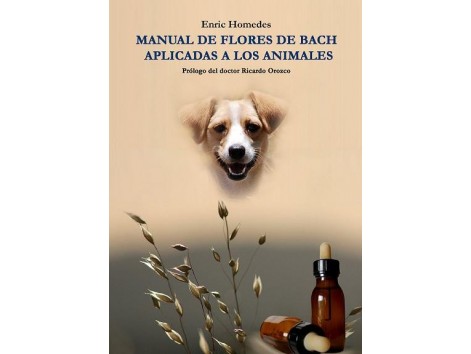More info
Language: Spanish Book ofSpain.
Book - Bach Flower Manual applied to animals. Enric Homedes - Trainer and Bach Flower Therapist specializing in animals. Educator canine. Language: Spanish After several years of implementing the remedies for animals, I see that respond to treatment faster than humans. The animals live the emotions of a more linear, with no mental amplification without intellectual analysis, and without having to integrate or take the emotion. The feel and express at the time, so full and intense. Bach Flowers are becoming increasingly known in the world of veterinary and canine education, being increasingly used by professionals in these fields. The work shown in this book, approached from the figure of floral therapist has as main objective to spread the application of flower remedies to the animal world both in the professional fields mentioned above, as between the owners of animals, and various protective foundations that promote the protection of stray animals and adopt them. It should be noted the great work that the remedies taken place in the animal, to facilitate the adaptation of it to his new home. This prevents "returns" unnecessary. This book is intended as a practical guide also helps to solve the most common behavior problems of the animal world, and thus improve relationships and adaptation to the world around them (other animals, babies, children, their owners, the environment, etc.). Notwithstanding the foregoing, this manual does not attempt to supplant the work of the veterinarian or canine educator. When an animal has a behavior problem, we must first go to the vet to rule out whether any changes in their behavior is based on a physical problem. We must also realize that in any therapy to treat behavioral problems, we must always consider what share of responsibility with the owners or the environment where the animal lives in this anomalous behavior. In this regard it is essential the guidelines of an ethologist or an educator that teaches dog owners not to humanize the animal's feelings and discern where conduct, though annoying, is part of the intrinsic nature of the animal or when conduct is pathological. And finally, stress the need for close collaboration between veterinarians, educators and therapists floral canines to ensure proper resolution of a problem of animal behavior. Foreword by DR. RICARDO OROZCO: No doubt this book fills an important gap in the literature floral. I am sure that will hereinafter as a link between the flower essences and our animal friends. This is an honest and documented. Enric Homedes know who we know loves and defends vigorously the animals, a fact reflected in their daily work with them and for them. This commitment involves the study of temperament, psychology, instincts, his life in captivity. And this is no small thing, because I often see how, in our ignorance, we try to understand animal behaviors projecting on them. Something like what would I do instead? It is easy to deduce that the result is the confusion that often, as noted by the author, all too often ends with the abandonment or enforcement of this animal. "Sacrifice" seems an understatement sugarcoated. But what actually causes me more wonder in this book is that it is written by someone who knows the remedies for a long time and has great experience with them. I am thrilled that provides extensive casuistry, which shows that it is not written from the sedentary indulgent speculation, but from constant practice, methodical and, above all, serious. I see that many therapists Floral, when faced with a skeptical Bach Flower, argue its rapid effect on animals, babies and plants, where the placebo effect is obviously impossible. Homedes professional experience, poured forth in part in this book reminds us again that Bach Flower Therapy is not a question of faith but of technical knowledge, good practice, method. Hopefully, this work reaches the dissemination it deserves and serve to help these wonderful creatures that we offer everything for almost nothing: the animals



Follow us